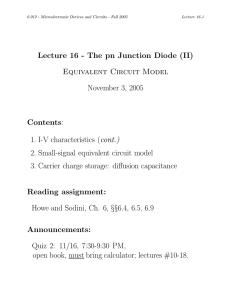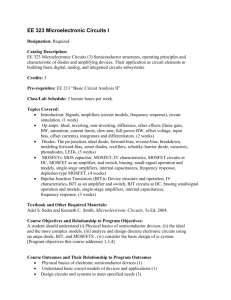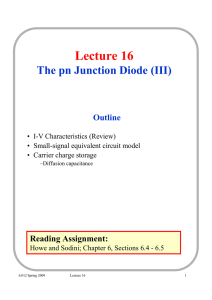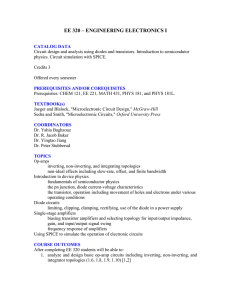Lecture 16 - The pn Junction Diode (II) Contents Equivalent Circuit Model
advertisement
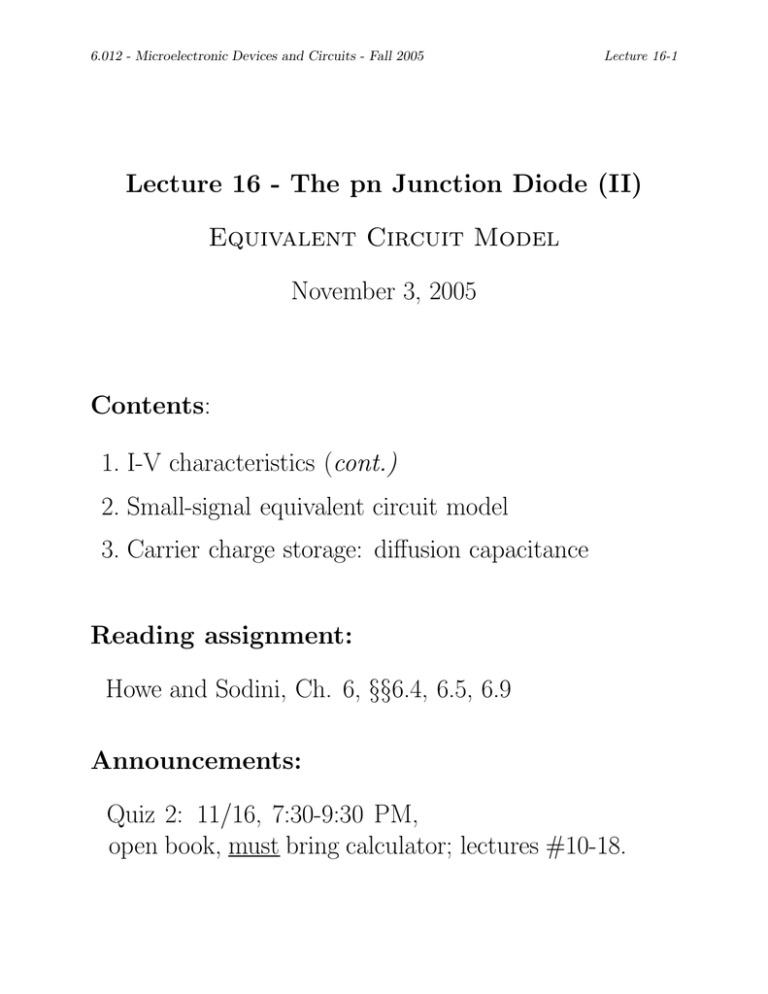
6.012 - Microelectronic Devices and Circuits - Fall 2005 Lecture 16-1 Lecture 16 - The pn Junction Diode (II) Equivalent Circuit Model November 3, 2005 Contents: 1. I-V characteristics (cont.) 2. Small-signal equivalent circuit model 3. Carrier charge storage: diffusion capacitance Reading assignment: Howe and Sodini, Ch. 6, §§6.4, 6.5, 6.9 Announcements: Quiz 2: 11/16, 7:30-9:30 PM, open book, must bring calculator; lectures #10-18. 6.012 - Microelectronic Devices and Circuits - Fall 2005 Lecture 16-2 Key questions • How does a pn diode look like from a small-signal point of view? • What are the leading dependences of the small-signal elements? • In addition to the junction capacitance, are there any other capacitive effects in a pn diode? 6.012 - Microelectronic Devices and Circuits - Fall 2005 Lecture 16-3 1. I-V characteristics (cont.) Diode current equation: I = Io(exp qV − 1) kT Physics of forward bias: Fp p n Fn • potential difference across SCR reduced by V ⇒ minority carrier injection in QNR’s • minority carrier diffusion through QNR’s • minority carrier recombination at surface of QNR’s • large supply of carriers available for injection ⇒ I ∝ eqV /kT 6.012 - Microelectronic Devices and Circuits - Fall 2005 Lecture 16-4 Fp p n Fn Physics of reverse bias: • potential difference across SCR increased by V ⇒ minority carrier extraction from QNR’s • minority carrier diffusion through QNR’s • minority carrier generation at surface of QNR’s • very small supply of carriers available for extraction ⇒ I saturates to small value 6.012 - Microelectronic Devices and Circuits - Fall 2005 Lecture 16-5 I-V characteristics: I = Io(exp qV − 1) kT I log |I| 0.43 q kT =60 mV/dec @ 300K Io 0 0 Io linear scale V 0 semilogarithmic scale V 6.012 - Microelectronic Devices and Circuits - Fall 2005 Source/drain-body pn diode of NMOSFET: Lecture 16-6 6.012 - Microelectronic Devices and Circuits - Fall 2005 Lecture 16-7 Key dependences of diode current: I = qAn2i ( Dn Dp 1 1 qV − 1) + )(exp Na Wp − xp Nd Wn − xn kT n2i qV (exp N kT •I∝ − 1) ≡ excess minority carrier concentration at edges of SCR n2i N – in forward bias: I ∝ exp qV kT : the more carrier are injected, the more current flows n2i −N : – in reverse bias: I ∝ the minority carrier concentration drops to negligible values and the current saturates • I ∝ D: faster diffusion ⇒ more current 1 : shorter region to diffuse through ⇒ more • I ∝ WQNR current • I ∝ A: bigger diode ⇒ more current 6.012 - Microelectronic Devices and Circuits - Fall 2005 Lecture 16-8 2. Small-signal equivalent circuit model Examine effect of small signal overlapping bias: q(V + v) − 1] I + i = Io[exp kT If v small enough, linearize exponential characteristics: I + i = Io(exp qv qv qV qV exp − 1) ' Io [exp (1 + ) − 1] kT kT kT kT = Io(exp qV qV qv − 1) + Io(exp ) kT kT kT Then: q(I + Io) i= v kT From small signal point of view, diode behaves as conductance of value: gd = q(I + Io) kT 6.012 - Microelectronic Devices and Circuits - Fall 2005 Small-signal equivalent circuit model, so far: gd gd depends on bias. In forward bias: qI gd ' kT gd is linear in diode current. Lecture 16-9 6.012 - Microelectronic Devices and Circuits - Fall 2005 Lecture 16-10 Must add capacitance associated with depletion region: gd Cj Depletion or junction capacitance: Cj = Cjo 1 − φVB s 6.012 - Microelectronic Devices and Circuits - Fall 2005 Lecture 16-11 3. Carrier charge storage: diffusion capacitance What happens to the majority carriers? Carrier picture so far: log p, n Na po Nd no p n ni2 Nd ni2 Na 0 x If in QNR minority carrier concentration ↑ but majority carrier concentration unchanged ⇒ quasi-neutrality is violated. 6.012 - Microelectronic Devices and Circuits - Fall 2005 Lecture 16-12 Quasi-neutrality demands that at every point in QNR: excess minority carrier concentration = excess majority carrier concentration n-QNR n n(xn) n(x) qNn Nd p p(xn) p(x) qPn ni2 Nd 0 xn Wn x Mathematically: p0 (x) = p(x) − po ' n0 (x) = n(x) − no Define integrated carrier charge: qP n = qA 12 p0 (xn)(Wn − xn) = = 2 Wn −xn ni qA 2 Nd (exp qV kT − 1) = −qN n 6.012 - Microelectronic Devices and Circuits - Fall 2005 Lecture 16-13 Now examine small increase in V : n-QNR n V +- n(xn) - I ∆qNn=-∆qPn p n(x) n Nd p p(xn) + ∆qPn p(x) ni2 Nd 0 xn Wn x Small increase in V ⇒ small increase in qP n ⇒ small increase in |qN n| Behaves as capacitor of capacitance: Cdn = dqP n |V dV 6.012 - Microelectronic Devices and Circuits - Fall 2005 Lecture 16-14 Can write qP n in terms of Ip (portion of diode current due to holes in n-QNR): qP n Dp (Wn − xn)2 n2i qV − 1) = qA (exp 2Dp Nd Wn − xn kT (Wn − xn)2 = Ip 2Dp Define transit time of holes through n-QNR: τT p (Wn − xn)2 = 2Dp Transit time is average time for a hole to diffuse through n-QNR [will discuss in more detail in BJT] Then: qP n = τT p Ip and Cdn ' q τT pIp kT 6.012 - Microelectronic Devices and Circuits - Fall 2005 Lecture 16-15 Similarly for p-QNR: qN p = τT nIn Cdp q ' τT nIn kT where τT n is transit time of electrons through p-QNR: τT n (Wp − xp)2 = 2Dn Both capacitors sit in parallel ⇒ total diffusion capacitance: Cd = Cdn + Cdp = q q (τT nIn + τT pIp ) = τT I kT kT with: τT nIn + τT p Ip τT = I Note that qP n + qN p = τT nIn + τT p Ip = τT I 6.012 - Microelectronic Devices and Circuits - Fall 2005 Lecture 16-16 Complete small-signal equivalent circuit model for diode: gd Cj Cd 6.012 - Microelectronic Devices and Circuits - Fall 2005 Lecture 16-17 Bias dependence of Cj and Cd : C Cd C 2Cjo 0 Cj φB/2 V 0 • Cd dominates in strong forward bias (∼ eqV /kT ) dominates in reverse bias and small forward bias • Cj √ (∼ 1/ φB − V ) - For strong forward bias, model for Cj invalid (doesn’t blow up) - Common ”hack”, let Cj saturate at value corresponding to V = φ2B √ Cj,max = 2Cjo 6.012 - Microelectronic Devices and Circuits - Fall 2005 Lecture 16-18 Key conclusions Small-signal behavior of diode: • conductance: associated with current-voltage characteristics gd ∼ I in forward bias, negligible in reverse bias • junction capacitance: associated with charge modulation in depletion region r Cj ∼ 1/ φB − V • diffusion capacitance: associated with charge storage in QNR’s to keep quasi-neutrality Cd ∼ eqV /kT Cd ∼ I
